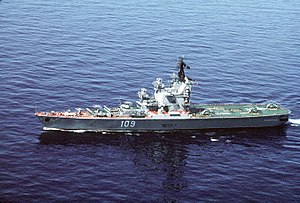Moskva-class_helicopter_carrier
Moskva-class helicopter carrier
Soviet helicopter carrier class
The Moskva class, Soviet designation Project 1123 Kondor (condor) and S-703 Project 1123M Kiev, was the first class of operational aircraft carriers (helicopter cruisers in the Soviet classification) built by the Soviet Union for the Soviet Navy.[3]
This article includes a list of general references, but it lacks sufficient corresponding inline citations. (January 2013) |
These ships were laid down at Nikolayev South (Shipyard No.444). The lead vessel was launched in 1965 and named Moskva (Russian: Москва, lit. 'Moscow'); she entered service two years later. Moskva was followed by Leningrad (Russian: Ленинград, lit. 'Leningrad', which was commissioned in late 1968; there were no further vessels built, reportedly due to the poor handling of the ships in rough seas. Both were conventionally powered.
The Moskvas were not true "aircraft carriers" in that they did not carry any fixed-wing aircraft; the air wing was composed entirely of helicopters. They were designed primarily as anti-submarine warfare (ASW) vessels, and her weapons and sensor suite was optimized against the nuclear submarine threat. Their strategic role was to defend the Soviet ballistic missile submarine bastions against incursions by Western attack submarines, forming the flagships of an ASW task force.[citation needed]
